47
OTTO DIX (Untermhaus, near Gera, Germany, 1891-Singen (Hohentwiel), 1969)."Portrait of Ursus",
"Portrait of Ursus", 1927.
Pencil and sanguine drawing on paper.
Signed and dated in the lower margin.
Size: 31 x 37 cm.
A representative of the New Objectivity and German Expressionism, Otto Dix became popular for his paintings of war painted during the First World War, a war in which he enlisted as a volunteer. Notable works from this period include Artillery (1914, Kunstmuseum, Düsseldorf) and The War (1929-1930, Dresden Museum), The Trench (Schützengraben 1921-1923) and the series of 50 etchings entitled War (1924). His output includes 500 sketches and various portraits, as well as canvases and watercolours evoking the Renaissance period. Otto Dix trained at the School of Decorative Arts in Dresden, where he remained until 1914. After the war he returned to Dresden, where he studied at the Academy of Fine Arts and worked as an independent artist, forming part of the Dresdner Sezession Gruppe from 1919, while participating in group exhibitions throughout Germany. He subsequently became a leading figure in the New Objectivity movement, with works that evinced his revulsion at the social injustice of post-war Germany. The acid colours of his compositions attest to this. From 1927 to 1933 Dix taught at the Dresden Academy until 1937, when he was dismissed by the Nazis, who included him in their Entartete Kunst (Degenerate Art) exhibition. Some of his paintings were burnt. From 1930 onwards his works show a period in which he stylistically approached both Lucas Cranach the Elder, Albrecht Dürer and Matthias Grünewald and Expressionist forms. In 1939 he was arrested and falsely accused of being involved in a plot against Adolf Hitler, but was later released. Without leaving Germany, he retired to Hemmenhofen on Lake Constance, where he devoted himself to landscape painting and depicting religious themes in a style close to that of Albrecht Altdorfer. He is currently represented in the Museo Thyssen Bornemisza, the Fundación Juan March, the Kunstmuseum in Düsseldorf, the Dresden Museum, the Schützengraben and the Bern Art Museum, among many other institutions worldwide.
"Portrait of Ursus", 1927.
Pencil and sanguine drawing on paper.
Signed and dated in the lower margin.
Size: 31 x 37 cm.
A representative of the New Objectivity and German Expressionism, Otto Dix became popular for his paintings of war painted during the First World War, a war in which he enlisted as a volunteer. Notable works from this period include Artillery (1914, Kunstmuseum, Düsseldorf) and The War (1929-1930, Dresden Museum), The Trench (Schützengraben 1921-1923) and the series of 50 etchings entitled War (1924). His output includes 500 sketches and various portraits, as well as canvases and watercolours evoking the Renaissance period. Otto Dix trained at the School of Decorative Arts in Dresden, where he remained until 1914. After the war he returned to Dresden, where he studied at the Academy of Fine Arts and worked as an independent artist, forming part of the Dresdner Sezession Gruppe from 1919, while participating in group exhibitions throughout Germany. He subsequently became a leading figure in the New Objectivity movement, with works that evinced his revulsion at the social injustice of post-war Germany. The acid colours of his compositions attest to this. From 1927 to 1933 Dix taught at the Dresden Academy until 1937, when he was dismissed by the Nazis, who included him in their Entartete Kunst (Degenerate Art) exhibition. Some of his paintings were burnt. From 1930 onwards his works show a period in which he stylistically approached both Lucas Cranach the Elder, Albrecht Dürer and Matthias Grünewald and Expressionist forms. In 1939 he was arrested and falsely accused of being involved in a plot against Adolf Hitler, but was later released. Without leaving Germany, he retired to Hemmenhofen on Lake Constance, where he devoted himself to landscape painting and depicting religious themes in a style close to that of Albrecht Altdorfer. He is currently represented in the Museo Thyssen Bornemisza, the Fundación Juan March, the Kunstmuseum in Düsseldorf, the Dresden Museum, the Schützengraben and the Bern Art Museum, among many other institutions worldwide.
24th November - 19th & 20th Century Arts & Berlanga´s Privat Collection
Sale Date(s)
Venue Address
General delivery information available from the auctioneer
Setdart offers Worldwide shipping
PICK UP IN ROOM: You can come and pick up your lots in our offices (Barcelona, Madrid or Valencia). At the moment of the withdrawal, you will be able to accept the current conditions of the lot by means of a document that you will sign.
YOU CAN SEND ANOTHER PERSON TO PICK UP: This person must present a signed authorization that you can find in our web page by accessing from BUY AT SETDART- LOGISTICS-DOWNLOAD AUTHORIZATION DOCUMENT. You can also send an e-mail with the requested data in AUTHORIZATION DOCUMENT to admin@setdart.com
Important Information
25% buyer´s premium
OR
21% buyer´s premium at www.setdart.com
Terms & Conditions
The maximum period to pay the lots is 7 working days. You can pay either via bank transfer or with credit card through our platform www.setdart.com (we only accept VISA or Mastercard).
BUYER´S PREMIUM: 22% Hammer price + 21% VAT from the buyer´s premium
If your piece has more than 100 years, our Ministry of Culture requires an export certificate in order for the piece to leave the country. Note that if the piece goes inside the EU, there is no cost for the export certificate. If the piece goes outside the EU, there is a cost for the export certificate. You can find more information in our Ministry of Culture website: https://www.culturaydeporte.gob.es/en/cultura/patrimonio/exportacionimportacion/exportacion/tasas.html
INQUIRIES: admin@setdart.com
Setdart guides you through the entire process, from the time of award to the day you receive your lot. Our logistics team will be happy to manage your transport, and will advise you on the best shipping method with professionals from the sector used to handling works of art and jewelry.
WE OFFER WORLDWIDE DOOR TO DOOR SHIPPING
PICK UP IN ROOM: You can come and pick up your lots in our offices. At the moment of the withdrawal, you will be able to accept the current conditions of the lot by means of a document that you will sign.
YOU CAN SEND ANOTHER PERSON TO PICK UP: This person must present a signed authorization that you can find in our web page by accessing from BUY AT SETDART-LOGISTICS-DOWNLOAD AUTHORIZATION DOCUMENT. You can also send an e-mail with the requested data in AUTHORIZATION DOCUMENT to admin@setdart.com
SETDART IS NOT RESPONSIBLE FOR THE STATE OF THE PARTS ONCE THEY LEAVE OUR FACILITIES. MRW SHIPMENTS: Once the payment is made, your lot will be packed for shipment, the logistics department will send you an e-mail notifying you of the day it leaves our warehouse, changes of address cannot be made after receiving this e-mail.
INSURANCE INCIDENTS: Coverage for the value of the auction up to 3000 ? per shipment, if the value of the auction is higher, Setdart will send you a quote including the additional insurance. The insurance company WILL NOT BE RESPONSIBLE FOR THE SHIPMENT THAT EXCEEDS THAT AMOUNT AND IS NOT FULLY INSURED. MRW INCIDENTS: Maximum notification 48 hours after receipt, after which the insurance company WILL NOT BE RESPONSIBLE AND NO CLAIMS WILL BE ACCEPTED.
E-MAIL LOGISTICS: logistica@setdart.com
PICK UP YOUR MESSAGES: You can send your own messaging, prior notice via e-mail that your shipment is ready, please note 3 or 4 days in advance. This type of shipment is packaged so Setdart will provide you with a quote.
EXPENSES FOR STORAGE: We inform you that if the purchased lot is not picked up within a month, you will be charged 30€ per week per lot. Setdart Online S.L., owner of the web site "setdart.com", "setdart.net" and "setdart.org", acts as a company of Spanish nationality inscribed in the Volume 36955, sheet 182, page B-293056 of the Mercantile Registry, with registered office at Calle Aragó









